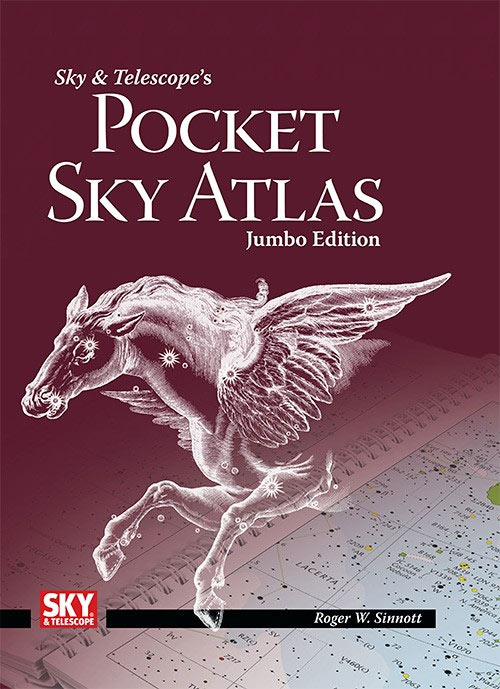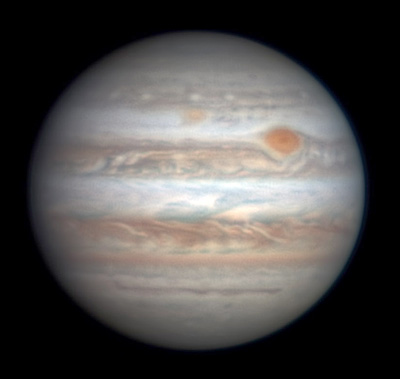Astronomy - This Week’s Sky at a Glance, January 20 – 28

Mars and Venus have been creeping closer together for months, and this week they close from 7° to 6° apart. But they're not going to pass each other. They'll be closest, 5½° apart, in early February, and then Venus will begin to drop back down and away.
Friday, January 20
• After dinnertime, the bright, equilateral Winter Triangle glitters in the southeast. Sirius is its lowest and brightest star. Betelgeuse stands above Sirius by about two fists at arm's length. To the left of their midpoint is Procyon.
• Vesta, the brightest asteroid, is magnitude 6.2 this week. It's just past opposition, looping high near Castor and Pollux. Binoculars will show it; see article and finder chart.
Saturday, January 21
• Is your sky dark enough for you to see the winter Milky Way? After dinnertime it runs vertically up and across the zenith: from Canis Major low in the southeast, up between Orion and Gemini, through Auriga and Perseus almost straight overhead, and down through Cassiopeia, Cepheus, and Cygnus to the northwest horizon.
• Early in the dawn of Sunday the 22nd, spot the waning crescent Moon hanging in the southeastern sky. Some 12° below it (for North America) is Antares. Look 15° to the left or lower left of Antares for Saturn. The same distance lower left of Saturn is Mercury.
Sunday, January 22
• Zero-magnitude Capella high overhead, and equally bright Rigel in Orion's foot, are at almost the same right ascension. This means they cross your sky’s meridian at almost exactly the same time: around 9 p.m. now, depending on how far east or west you live in your time zone. (Capella goes exactly through the zenith if you're at latitude 46° north: Portland, Oregon; Montreal; central France.) So, whenever Capella passes its very highest, Rigel always marks true south over your landscape. And vice versa.
Monday, January 23
• In early dawn Tuesday morning the 24th, look southeast for the waning crescent Moon hanging 3° upper left of Saturn (when seen by North America), as shown here.
Tuesday, January 24
• As dawn brightens on Wednesday morning the 25th, look very low in the southeast for the thin waning crescent Moon, as shown here. Saturn is about 14° to the upper right of it (for North America). Little Mercury is about 6° below the Moon. Binoculars will help, especially as dawn grows brighter.
Wednesday, January 25
• Sirius twinkles brightly after dinnertime below Orion in the southeast. Around 8 p.m., depending on your location, Sirius shines precisely below Betelgeuse in Orion's shoulder. How accurately can you time this event for your location, perhaps using a plumb bob or the vertical edge of a building? Of the two, Sirius leads early in the evening; Betelgeuse leads later.
Thursday, January 26
• Right after dark this week, face east and look very high, almost overhead. The bright star there is Capella, the Goat Star. To the right of it, by a couple of finger-widths at arm's length, is a small, narrow triangle of 3rd and 4th magnitude stars known as "the Kids." Although they're not exactly eye-grabbing, they form a never-forgotten asterism with Capella.
Friday, January 27
• The sky's biggest asterism (informal star pattern) — at least the biggest that's widely recognized — is the Winter Hexagon. It now fills the sky toward the east and south after dinnertime. Start with brilliant Sirius at its bottom. Going clockwise from there, march through Procyon, Pollux and Castor, Menkalinan and Capella very high, Aldebaran over to
Capella's lower right, down to Rigel in Orion's foot, and back to Sirius.
Capella's lower right, down to Rigel in Orion's foot, and back to Sirius.
Betelgeuse shines inside the Hexagon, off center.
• New Moon (exact at 7:07 p.m. EST).
Saturday, January 28
• After dark now the Great Square of Pegasus is sinking down in the west, tipped onto one corner to the right or upper right of Venus and Mars. Meanwhile the Big Dipper is creeping up in the north-northeast, tipped up on its handle.
_________________________
Want to become a better astronomer? Learn your way around the constellations! They're the key to locating everything fainter and deeper to hunt with binoculars or a telescope.
This is an outdoor nature hobby. For an easy-to-use constellation guide covering the whole evening sky, use the big monthly map in the center of each issue of Sky & Telescope, the essential guide to astronomy.

The Pocket Sky Atlas plots 30,796 stars to magnitude 7.6 — which may sound like a lot, but it's less than one per square degree on the sky. Also plotted are many hundreds of telescopic galaxies, star clusters, and nebulae. Shown above is the new Jumbo Edition for easier reading in the night. Click image for larger view.
Once you get a telescope, to put it to good use you'll need a detailed, large-scale sky atlas (set of charts). The basic standard is the Pocket Sky Atlas (in either the original or new Jumbo Edition), which shows stars to magnitude 7.6.
Next up is the larger and deeper Sky Atlas 2000.0, plotting stars to magnitude 8.5; nearly three times as many. The next up, once you know your way around, is the even larger Uranometria 2000.0 (stars to magnitude 9.75). And read how to use sky charts with a telescope.
You'll also want a good deep-sky guidebook, such as Sue French's Deep-Sky Wonders collection (which includes its own charts), Sky Atlas 2000.0 Companion by Strong and Sinnott, or the bigger Night Sky Observer's Guide by Kepple and Sanner.
Can a computerized telescope replace charts? Not for beginners, I don't think, and not on mounts and tripods that are less than top-quality mechanically (meaning heavy and expensive). And as Terence Dickinson and Alan Dyer say in their Backyard Astronomer's Guide, "A full appreciation of the universe cannot come without developing the skills to find things in the sky and understanding how the sky works. This knowledge comes only by spending time under the stars with star maps in hand."
This Week's Planet Roundup
Mercury and Saturn are low in the southeast in early dawn. But Mercury (magnitude –0.2) is sinking lower every day, while Saturn (magnitude +0.5) is moving higher into much better view to Mercury's upper right. They widen from 14° to 22° apart this week.
Antares, magnitude +1.0, twinkles 15° to Saturn's right or upper right. The waning crescent Moon passes through this area on the mornings of January 23rd through 26th, as shown above.
Venus is the brilliant "Evening Star" this winter, high in the southwest during twilight and long after. It's currently magnitude –4.7, between Aquarius and Pisces. To its upper left you'll spot Mars, an orange less than 1% as bright.
In a telescope Venus is now slightly less than half sunlit. It's growing larger as it approaches us, now about 28 arcseconds from cusp to cusp. For the rest of the winter, Venus will continue to enlarge as its phase wanes down to a thin crescent.
Venus in a telescope is least glary when viewed in bright twilight. So get your scope on it as soon as you can see it naked-eye.
Mars (magnitude +1.1) is the fainter "star" upper left of Venus. The separation between them shrinks from 7° to 6° this week. In a telescope Mars is just a tiny fuzzblob 5 arcseconds wide.
Vesta, just past opposition, is a very accessible magnitude 6.2. Article and finder chart.

Jupiter's Great Red Spot side on January 12th, imaged by Christopher Go. Upper left of the Great Red Spot, the small, pale-orange Oval BA has just crossed the central meridian. South is up. In the northern hemisphere, the North Equatorial Belt and North Temperate Belt have almost blended to become one very wide belt.
Jupiter (magnitude –2.1, in Virgo) rises around 11 or midnight and shines brightly high in the south before the first light of dawn. Spica dangles 3½° below or lower right of it. Jupiter is creamy white; Spica is an icier shade of white with a trace of blue (once it's fairly high up).
In a telescope Jupiter is 38 arcseconds in diameter, on its way to 44 arcseconds for late March through April. (Opposition is April 7th.)
Uranus (magnitude 5.8, in Pisces) is still high in the southwest right after dark.
Neptune (magnitude 7.9, in Aquarius) is getting low in the west-southwest right after the end of twilight. Finder charts for Uranus and Neptune.
__________________________
All descriptions that relate to your horizon — including the words up, down, right, and left — are written for the world's mid-northern latitudes. Descriptions that also depend on longitude (mainly Moon positions) are for North America.
Eastern Standard Time (EST) is Universal Time (UT, UTC, or GMT) minus 5 hours.
__________________________
"This adventure is made possible by generations of searchers strictly adhering to a simple set of rules. Test ideas by experiments and observations. Build on those ideas that pass the test. Reject the ones that fail. Follow the evidence wherever it leads, and question everything. Accept these terms, and the cosmos is yours."
— Neil deGrasse Tyson
— Neil deGrasse Tyson

No comments:
Post a Comment